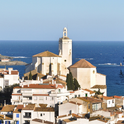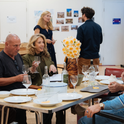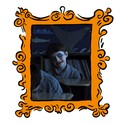The Butterfly Nebula, part of an exibition of astronomical images at the National Maritime Museum (© Nasa ESA and the Hubble SM4 ERO Team)
Science exhibition
Visions of the UniverseNational Maritime Museum, from 7th June
This self-described “collection of some of the best astronomical photographs ever made” brings together so many science history firsts that it can be hard to form an adequate response. The exhibition starts with the origins of astronomical imaging, with hand drawings Galileo made as he looked through his telescope. It goes on to explain the significance of other landmark images, such as photographs Edwin Hubble took in 1923, which proved that galaxies beyond ours exist. The beauty of these images is not overlooked. The winning entries from the Astronomy Photographer of the Year competition are on display too, with images capturing the skies in often personal ways.
The most exhilarating exhibit is the “Mars Window.” A curved screen 13m wide, it shows images transmitted live to Earth from the Mars Curiosity Rover, launched in 2011. In April, Mars was obscured from the Earth by the Sun, and communication with spacecraft paused. Transmission will resume just in time for the opening of this exhibition.
Laura Marsh
Theatre
If OnlyMinerva Theatre, Chichester, 14th June to 27th July
David Edgar invariably gives left-wing drama a good name, chiefly because he’s very clever, knows his stuff and is good at identifying crisis points in history. This time, he’s speculating about the 2015 election in a meeting of three politicians from the major parties. So you’ll soon be able to say, “Have you seen the one about the Labour special advisor, the Lib Dem staffer and the Tory candidate?” The three of them first meet in Malaga airport in April 2010, stranded there by the Icelandic ash cloud.
Now it’s August 2014 and, as the nation prepares for the centenary of the First World War, they meet again. One of them has some information that could radically change the election outcome. I don’t think we’re necessarily talking a projected Ukip landslide here, or a deal with Nigel Farage, though you never know with Edgar; he’s unlikely to sound anything but bang on the money and right up to date.
Michael Coveney
Film
Behind the CandelabraOn release from 14th June
In 2005 the drama Brokeback Mountain, about a relationship between two cowboys, won an Oscar for director Ang Lee. Half a dozen years later, another Oscar-winning director, Steven Soderbergh, sought in vain to fund an adaptation of Behind the Candelabra, Scott Thorson’s memoir of his affair with the entertainer Liberace, a man who strenuously (and litigiously) denied his homosexuality to the public. Soderbergh had glittering stars—Michael Douglas and Matt Damon, no less—but the studios told him the story was “too gay.” Who would watch it? they said. TV company HBO stepped in to produce a small-screen version and thanks to enthusiastic European theatrical distributors (and Cannes selectors) now we get Candelabra in cinemas. Bring on the boys! Marvel at their preternatural youth onscreen, the elaborate costumes, the cameo performance by Liberace’s old pal Debbie Reynolds! So what if it threatens to be the same old love-gone-wrong melodrama, with extra plastic surgery? With this cast and pedigree and with Soderbergh’s recent threat to retire from directing for the big screen, how could you resist?
Francine Stock
Art
Patrick CaulfieldTate Britain, from 5th June
A retrospective at Tate Britain this summer will shine a light on the first, true Brit Pop. Born in 1936, Patrick Caulfield was a signature stylemaker of an irreverent art, flashing its bright colours just as the Beatles and Rolling Stones brought London to the world’s fascinated attention.
Caulfield’s single-tone, self-consciously designed paintings of interiors originally owed much, by his own admission, to the moody American, Edward Hopper. He seems to have arrived early at a highly distinctive style and knew, for 50 exuberant years on canvas, what worked—jugs, pottery, chairs, record players. A quiet man, who died in 2005, he disdained the epithet “Pop,” considering himself a formalist. At Tate Britain’s Linbury Galleries, the 30-plus Caulfield works on show—a significant number from private owners—will be complemented by a parallel exhibition of a new-generation Pop painter, Gary Hume (born 1962)—two pops, then, for the price of one.
James Woodall
Dance
The Forsythe CompanySadler’s Wells, 18th to 20th June
The US choreographer William Forsythe returns to Sadler’s Wells with his new work, Study #3. Originally premiered in Frankfurt in November 2012, the piece is a kind of physical reminiscence of 30 years at the cutting edge of ballet. Few modern choreographers understand the principles of ballet as well as Forsythe. He has an architect’s view of space and design, a cinematographer’s grasp of lighting and a sculptor’s eye for the representation of physical energy. Thinking well beyond the confines of conventional performance, Forsythe is just as likely to create art installations in a gallery—his work has appeared at the Louvre and the Tate Modern—as he is to present work on a stage.
Forsythe’s rigorous academic discipline and his boundless curiosity continue to take him and his company of superb dancers into places most choreographers can’t even contemplate. Study #3 is a unique opportunity to see a distillation of the themes, ideas and innovations selected from 30 works of a genuinely holistic dancemaker.
Neil Norman












